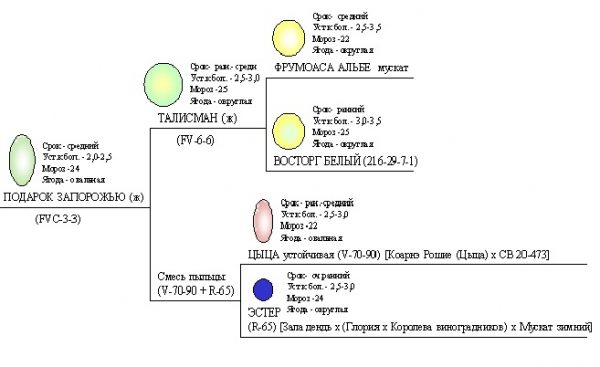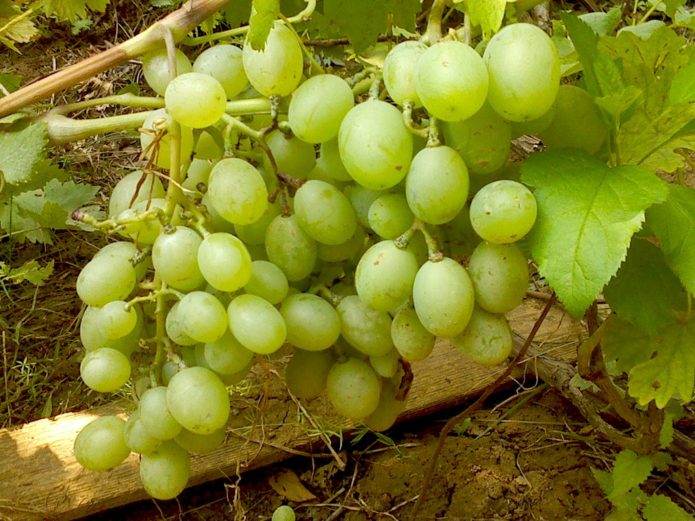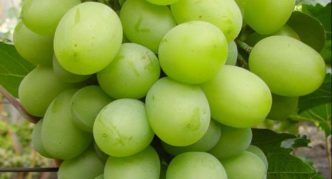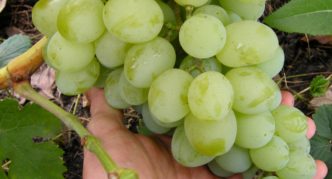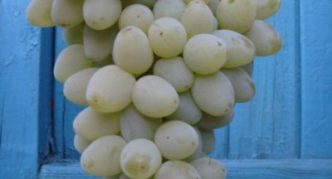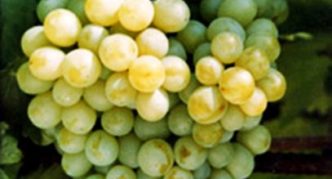In recent years, breeders have created many new grape hybrids, characterized by complex resistance to adverse weather conditions and diseases, as well as good taste and appearance of the fruit. But this does not mean that one should forget about the time-tested forms of this culture. Their striking representative is the Gift to Zaporozhye, which has been grown in the vineyards of Russia and Ukraine for more than a dozen years.
Content
History of breeding, description and characteristics of grapes Gift to Zaporozhye
Grapes The gift to Zaporozhye was received by the Ukrainian breeder E.A. Klyuchikov in the 80s of the last century as a result of pollination of the Talisman with a mixture of pollen from Tsytsa resistant and Esther. Despite its impressive age, this variety has not yet been included in the Registers of Breeding Achievements of Russia, Belarus and Ukraine, but this does not prevent the inhabitants of our states from successfully growing it in their vineyards and collecting an excellent harvest of sweet berries.
A present for Zaporozhye is a table grape variety of medium-early ripening period. Its berries begin to be harvested 125–145 days after the start of the growing season. In southern Russia, this period usually falls on the end of August and the beginning of September.
A gift to Zaporozhye is not very suitable for growing in the northern regions. Its berries often do not have time to ripen and gain enough sugar in a short summer, with few hot and sunny days.
Grape Gift to Zaporozhye is a vigorous bush with dark green, three-lobed, slightly dissected leaves. The flowers of this variety are functionally female, pollinating well even in adverse weather conditions. Nevertheless, some growers note its insufficient quality during prolonged rains, as a result of which peas of berries appear. The pollinator of the Gift of Zaporozhye can be any grape variety blooming in the same period.
The berries of the Gift to Zaporozhye are large, oval, when fully ripe, they are painted in a light green color, with a light, whitish bloom of prune. The bunches have a conical or cylindro-conical shape. Their weight ranges from 800 g to 2 kg. The yield is high. The proportion of fruiting shoots is 65–80%.
The progenitor of many table varieties is the Talisman grape, a well-deserved variety of early frost-resistant grapes:https://flowers.bigbadmole.com/en/yagody/vinograd/vinograd-talisman-opisanie-sorta-foto-otzyivyi.html
The pulp of the berries is very juicy, sometimes watery, with a simple, harmonious taste and a light apple aroma. It contains 16-19% sugars with an acidity of 5-6 g / l. The skin is firm.Tasting assessment of fresh fruits - 8.2 points out of 10. Gardeners who grow grapes for sale note their low transportability.
A gift to Zaporozhye tolerates temperatures as low as -24 ° C. It also has increased resistance to most fungal diseases of grapes. Berries of this variety are not prone to shedding and can be stored on the bush until mid-October, provided there is no frost. A large amount of moisture has a negative effect on them, which often leads to cracking of the fruit.
The gift to Zaporozhye is distinguished by good compatibility with other grape varieties, due to which it is often used as a rootstock or scion.
Video: overview of the Gift variety Zaporizhia
Features of planting and growing
Variety Gift Zaporozhye does not differ in particular exactingness to growing conditions and is perfect for novice winegrowers. Nevertheless, in order to obtain high yields of tasty and sweet berries, it is necessary to follow the basic rules of agricultural technology of this crop.
Landing
Like most other grape varieties, the Gift of Zaporozhye needs a lot of warmth and light. With their lack, the growth of the vine slows down, the number of fruits decreases and the ripening period is lengthened. Therefore, for planting this variety, it is better to choose sunny areas that are well protected from the wind.
The correct choice of planting material is no less important. One year old seedlings with a well-formed healthy root system and one or two vines take root best. You can prepare them yourself. For this, cuttings cut from a healthy plant are placed in water or a moist substrate with a volume of 1–1.5 liters and left at a temperature of 25–27 ° C. The Podarok Zaporozhye variety has a good ability to grow roots, so they usually appear no later than 4 weeks later. A young plant is planted in open ground after the roots have reached a length of three centimeters.
When planting several seedlings of the Gift of Zaporozhye at the same time, it is necessary to take into account the rather high growth force of its vine. In order for the plants not to interfere with each other, the distance between them should not be less than 2 m. In addition, the presence of a pollinator is necessary for the ovary of fruits. In this capacity, any varieties blooming in the same period can act, but experienced growers especially recommend representatives of raisins for this purpose. For instance:
- Radiant kishmish;
- Rusball;
- Kishmish Zaporozhye.
In the southern regions, the Gift of Zaporozhye is planted in open ground in spring or autumn. In regions with cold winters, it needs time to root and prepare for the cold, so planting is best done in late April-early May, after the ground warms up to 15 ° C.
The planting hole is prepared at least a month before planting the plant in open ground. If this event is planned for the spring, then it is better to dig it up and refuel before the beginning of winter. A big pit is not needed for a Gift to Zaporozhye. A hole 25–80 cm in diameter and 80–90 cm deep is enough for him. A drainage layer must be laid on its bottom to protect the plant roots from decay caused by stagnation of water. Then the hole is filled with dug earth mixed with humus and sand in a ratio of 2: 1: 1. You can also add 1-2 tablespoons of complex fertilizer and a couple of liters of ash to the soil.
During planting, the young plant is placed in a hole at an angle of 45 ° and carefully covered with fertile soil. In this case, the root collar should remain 4–5 cm above the surface. Then the grapes are tied to a pre-installed support, watered abundantly and mulched with any organic matter.
Watering and fertilizing
Usually, one watering per month is enough for a Gift to Zaporozhye. But at extremely high temperatures and prolonged drought, their number increases to 2 or 3.In addition, in the southern regions, which often suffer from a lack of precipitation, abundant watering of the vineyard is carried out in autumn and spring.
A gift to Zaporozhye, like other grape varieties, reacts negatively to moisture ingress on the green parts of the plant. In order to avoid this, drainage pipes or small holes dug around the perimeter of the trunk circle are used for irrigation. Drip irrigation also gives good results. But when using it, it is necessary to carefully monitor the wetting of the deep layers of the soil, where most of the roots of the grapes are located.
Fortunately, in most regions of central Russia, there is usually no shortage of rain, therefore, in other years, watering is almost not required: there is no need for extra water in the vineyard:https://flowers.bigbadmole.com/en/yagody/vinograd/vyirashhivanie-vinograda-v-sredney-polose-dlya-nachinayushhih.html
Video: root watering of grapes
Excessive watering is very dangerous for the Gift to Zaporozhye. It promotes fungal diseases and berry cracking. Stopping regular watering immediately after flowering grapes will help prevent damage to the crop.
A gift to Zaporozhye does not need frequent fertilization. To obtain high yields, fertilizing is carried out twice a season:
- After the plant leaves wintering, fertilizers are applied to the trunk circle, which include a large amount of nitrogen, for example, Nitrofosku or Kemiru-Lux.
- Before flowering, the bushes are fertilized with superphosphate (consumption rate is about 50 g per plant) and potassium sulfate (25 g).
To improve the absorption of nutrients, fertilization is combined with watering.
Prevention of insufficient pollination
Some growers complain about the poor pollination of the Gift by Zaporozhye during rainy weather. This leads to a decrease in yield and berry peas. You can avoid this by manually carrying the pollen to the flowers with a powder puff.
To improve pollination, preparations of the gibberellin group are sometimes used, which include phytohormones that stimulate the growth of fruits. But when using them, you must carefully follow the instructions. Overdosing on stimulants can backfire and cause the berries to grind.
Cropping and rationing of the crop
The gift to Zaporozhye needs regular pruning. For the first time, it is carried out immediately after planting the plant in open ground, leaving no more than 3 shoots on the bush.
In August, the vine is minted, that is, cut to a normal leaf. This procedure helps accelerate the ripening of the shoots and preserve the nutrients necessary for wintering.
After the end of the growing season, the time comes for the formative autumn grape pruning. During it, the vine is cut into 8-10 eyes, while their total number is reduced to 40-60 per bush. In the south, arbor molding is most often used, which increases the number and sugar content of berries, as well as their shelf life. In the northern regions, the bushes of the Gift to Zaporozhye are usually formed in the form of a fan.
This variety is prone to excessive fruit setting. An increased load often leads to crushing of the berries, a deterioration in their taste and an increase in the ripening period. Without negative consequences, each escape of the Gift to Zaporozhye can endure 1.5–1.8 menace. Excess inflorescences are removed without waiting for their pollination.
Disease and pest control
The Gift of Zaporozhye grapes inherited from their parents increased resistance to fungal diseases. To reduce the likelihood of plant infection to zero, preventative treatments with fungicides such as:
- bordeaux liquid;
- Topaz;
- Adjusted;
- Ridomil Gold.
To protect this variety from fungal diseases, 2 sprays per season are enough. They are carried out:
- immediately after removing the winter shelter;
- shortly before flowering.
The dense skin protects the Zaporozhye Gift berries well from wasps. But it is not an obstacle for birds who do not miss the chance to enjoy sweet and juicy fruits. They can be scared away from landings with ratchets, magnetic tapes or scarecrows.This problem is fundamentally solved by a fine-mesh mesh. They cover the bushes completely or use it to make bags in which they hide ripening bunches of grapes.
Preparation for wintering
In regions with winter temperatures below -24 ° C The gift to Zaporozhye needs a mandatory shelter for the winter. Before the onset of cold weather, the vine is removed from the trellises and laid on the ground, previously lined with spruce branches. From above, the plant is covered with a thick film or non-woven material.
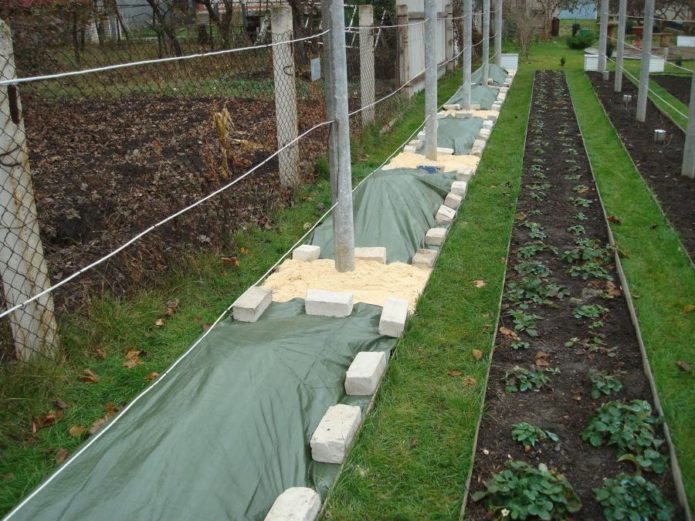
The edges of the covering material are covered with earth or fixed with bricks in order to avoid damage to the structure by strong wind
In the southern regions, adult bushes of the Gift to Zaporozhye winter well on trellises. But before they reach the age of three, it is better to play it safe and bend the vine to the ground, covering it with material that protects it from too low temperatures.
It is necessary to protect the wineries not only from the winter cold, but also from the return spring frosts. During the blooming of young tender buds, it is important not to allow them to be damaged even by a small spring sea:https://flowers.bigbadmole.com/en/yagody/vinograd/kak-ukryvat-vinograd-na-zimu.html
Advantages and disadvantages of the Gift to Zaporozhye in comparison with other similar varieties
Today, the choice of grape varieties is wider than ever. In order to understand whether the Gift of Zaporozhye deserves a place on the site, let's compare its main characteristics with the parameters of other table varieties of the mid-early ripening period with white berries.
| Variety name | Ripening period | Yield | Average bunch weight (g) | Average weight of berries (g) | Taste (tasting score) | Winter hardiness (° C) | Disease resistance |
| Gift to Zaporizhzhia | 125–145 | High | 600–900 | 10–12 | Simple (8.2) | -24 | Increased resistance to fungal diseases |
| Talisman (Kesha) | 127–135 | High | 450 | 12–16 | Simple (8.2) | -25 | Increased resistance to mildew and gray mold |
| Chrysolite (Monarch) | 120–130 | 239.5 c / ha | 600 | With a pronounced nutmeg flavor (8.6) | -25 | Affected by diseases in an average degree | |
| Liang | about 135 | 190 c / ha | 200–250 | 4–5 | Harmonious, with a pleasant aroma (8.1) | -22 | Resistant to most fungal diseases and phylloxera, but can be affected by bacterial cancer |
| Caramol | 120–130 | High | 300 | 5,2 | Simple, harmonious | -22 | Average |
Photo gallery: ripe bunches of compared varieties
- Large berries of grapes Gift from Zaporozhye have a rather simple taste
- The Talisman grape variety is distinguished by its complex resistance to diseases and adverse weather conditions
- Most winegrowers in Russia and the CIS countries know the Chrysolite variety under the name Monarch
- Ripe Liana berries are colored greenish-yellow
- Amber-green, rounded grapes Caramol are collected in conical clusters of medium density
As you can see from the table, the Podarok Zaporozhye variety has no equal in terms of the combination of high yield, large size of bunches and berries, as well as disease resistance. According to these indicators, only the Talisman, which is his close relative, can compete with him. But the Gift to Zaporizhzhia is somewhat inferior to other varieties in taste and aroma of berries.
Reviews of experienced winegrowers about the Gift of Zaporozhye
No taste. Just a gigantic look, and a bush, and bunches, and berries. For myself, I do not want - I will delete.
Last year I was not happy with it either - it is soft and not very tasty - I overloaded it because. This year I normalized it as it should be - it's a completely different matter. The pulp is like marmalade. It turns out that if the PZ is not overloaded and allowed to ripen - normal grapes! I liked the taste.
My PZ does not crack, there is not much sugar, everyone likes our family and they take it well on the market.
The first signal harvest at my Gift to Zaporozhye. Honestly, after landing, I regretted the choice, having read about the simple taste. But after waiting for ripening and tasting the berries from my bushes, I'm glad I left. I would not say that the taste is simple. I read somewhere about the taste of ripe apples, my wife recalled the taste of the pulp of an unripe white plum. In general, it can be called something, but not simple.And if you add painlessness, large berries, dense pulp, then now I do not regret planting this variety at all. It rained during flowering. therefore, peas are present, and besides, this is signal fruiting.
According to the results of 7 fruiting on its site, the most unpretentious of all available varieties! This year, apparently, it was frozen slightly, lagging behind in growth, but the harvest "pulls", tries with the hostess with all his might! Some berries, with a yellow barrel, are already very tasty !
My PZ is always pot-bellied, beautiful. I pollinated almost always well, I did not see any illnesses on it. But there were also some troubles: it ripened with me by September 5, and at this time it often rains, then it cracked godlessly. Immediately rotted, etc. This year - a rare event - there was no rain. But somehow no one wanted to eat it. There is almost no taste, the flesh is watery. Now this bush is a test one for grafting.
For myself, for the family, the variety is very good! The pulp is fleshy and juicy, the berry is large, not painful. And very productive, enough to feed all the relatives! But we removed it ... It's problematic to get to the market, and since we often go to the regional markets, but we live in Russia, and the roads in Russia are a dream ... almost all the berries burst and flowed. I had to leave. But if you do not trade, or trade somewhere in the place, next to it is an excellent variety!
Despite all its shortcomings, the Gift of Zaporozhye grape continues to be popular with gardeners in the south of Russia and Ukraine. They value this variety very much for its unpretentiousness and high yield, thanks to which it can be easily grown on its site even by a novice grower.
